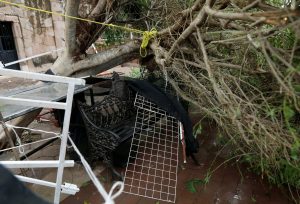
By David Alire Garcia
ESCUINAPA, Mexico (Reuters) – Residents on Mexico’s Pacific Coast on Wednesday began clearing up the wreckage left by Hurricane Willa, which ripped through towns overnight, tearing off rooftops, downing power lines and splitting trees apart.
Willa hit the northwestern state of Sinaloa late Tuesday as one of the strongest storms to lash the coast in recent years, with winds of up to 120 miles per hour (195 km per hour).
“I thought it was the end of the world,” said Alma Rosa Ramirez, a 45-year-old resident of the town of Escuinapa, as she described how her whole house rattled in the blasting winds.
Now with the sun peeking through and wind nearly at a standstill, Ramirez and scores of other residents took to the streets to pick up debris, while emergency crews poured in to work on reestablishing basic services.
Ramirez arrived at her tiny fruit and vegetable stand in the shadow of a large stone church in Escuinapa’s central square, saying she feared the storm had devastated the farming region that supplies her with the carrots, squash and chiles she sells.

Fallen tree is seen at the park in Escuinapa, near the southern tip of Sinaloa state after Hurricane Willa hit the area, Mexico October 24, 2018. REUTERS/Henry Romero
“There’s going to be a lot of poverty,” she said.
No deaths have been reported as thousands of people were evacuated from coastal towns and resorts before the storm hit.
“The population took cover in time,” said Luis Felipe Puente, head of the country’s Civil Protection agency, confirming that no deaths had been reported as of early on Wednesday.
On the other side of Escuinapa, 74-year-old retiree Virginia Medina sat in a white plastic chair, a 4-week-old kitten winding between her legs, as she took in the damage.
Willa showed her little mercy: a metal corrugated roof collapsed, water pooled in the kitchen and gnarled branches littered Medina’s front patio and backyard.
“I can’t even walk in my backyard … Here in the neighborhood a lot of walls came tumbling down. Now there is no power, no gas, there’s nothing,” Medina said.
Willa struck the coast about 50 miles (80 km) south of Mazatlan, a major city and tourist resort in Sinaloa, as a Category 3 hurricane on the five-step Saffir-Simpson scale.
The storm had reached rare Category 5 status on Monday, with winds nearing 160 miles per hour (260 kph), as it headed toward the coast.
The storm dissipated by mid-morning as it moved quickly inland over northwest-central Mexico on Wednesday. It was still expected to dump heavy rains across the region.
By then, the storm was about 75 miles (120 km) west of the city of Monterrey, blowing maximum sustained winds of 25 mph, the Miami-based U.S. National Hurricane Center said.
Downpours in Mexico prior to Willa’s arrival have heightened the risk of flooding, and the NHC said the storm could drench some areas in as much as 18 inches (45 cm) of rain.
(Additional reporting by Dave Graham and Brendan O’Brien; writing by Anthony Esposito and Daina Beth Solomon; editing by Robert Birsel, Helen Popper, Frances Kerry and G Crosse)
